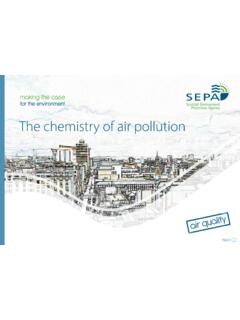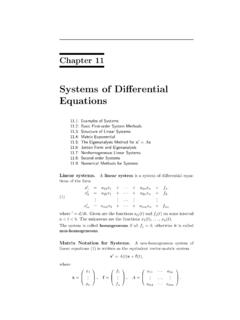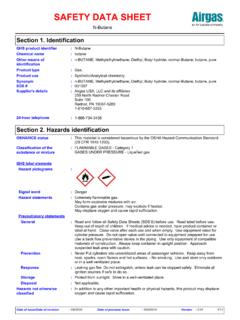Transcription of Air Pollution Control Technology Fact Sheet
1 EPA-452/F-03-015 Air Pollution Control Technology Fact SheetEPA-CICA Fact SheetPacked-Bed/Packed-Tower Scrubber1 Name of Technology : Packed-Bed/Packed-Tower Wet ScrubberThis type of Technology is a part of the group of air Pollution controls collectively referred to as wet scrubbers. When used to Control inorganic gases, they may also be referred to as acid gas scrubbers. Type of Technology : Removal of air pollutants by inertial or diffusional impaction, reaction with a sorbentor reagent slurry, or absorption into liquid Pollutants:Primarily inorganic fumes, vapors, and gases ( , chromic acid, hydrogen sulfide, ammonia, chlorides,fluorides, and SO2); volatile organic compounds (VOC); and particulate matter (PM), including PM less thanor equal to 10 micrometers ( m) in aerodynamic diameter (PM10), PM less than or equal to m inaerodynamic diameter ( ), and hazardous air pollutants (HAP) in particulate form (PMHAP).
2 Absorption is widely used as a raw material and/or product recovery technique in separation and purificationof gaseous streams containing high concentrations of VOC, especially water-soluble compounds such asmethanol, ethanol, isopropanol, butanol, acetone, and formaldehyde (Croll Reynolds, 1999). HydrophobicVOC can be absorbed using an amphiphilic block copolymer dissolved in water. However, as an emissioncontrol technique, it is much more commonly employed for controlling inorganic gases than for VOC. Whenusing absorption as the primary Control technique for organic vapors, the spent solvent must be easilyregenerated or disposed of in an environmentally acceptable manner (EPA, 1991). When used for PMcontrol, high concentrations can clog the bed, limiting these devices to controlling streams with relatively lowdust loadings (EPA, 1998).Achievable Emission Limits/Reductions: Inorganic Gases: Control device vendors estimate that removal efficiencies range from 95 to 99 percent(EPA, 1993).
3 VOC: Removal efficiencies for gas absorbers vary for each pollutant-solvent system and with the type ofabsorber used. Most absorbers have removal efficiencies in excess of 90 percent, and packed-towerabsorbers may achieve efficiencies greater than 99 percent for some pollutant-solvent systems. The typicalcollection efficiency range is from 70 to greater than 99 percent (EPA, 1996a; EPA, 1991). PM: Packed-bed wet scrubbers are limited to applications in which dust loading is low, and collectionefficiencies range from 50 to 95 percent, depending upon the application (EPA, 1998).Applicable Source Type: PointTypical Industrial Applications:The suitability of gas absorption as a Pollution Control method is generally dependent on the following factors:1) availability of suitable solvent; 2) required removal efficiency; 3) pollutant concentration in the inlet vapor;EPA-CICA Fact SheetPacked-Bed/Packed-Tower Scrubber24) capacity required for handling waste gas; and, 5) recovery value of the pollutant(s) or the disposal cost ofthe unrecoverable solvent (EPA, 1996a).
4 Packed-bed scrubbers are typically used in the chemical, aluminum,coke and ferroalloy, food and agriculture, and chromium electroplating industries. These scrubbers have hadlimited use as part of flue gas desulfurization (FGD) systems, but the scrubbing solution flow rate must becarefully controlled to avoid flooding (EPA, 1998; EPA, 1981). When absorption is used for VOC Control , packed towers are usually more cost effective than impingementplate towers. However, in certain cases, the impingement plate design is preferred over packed-towercolumns when either internal cooling is desired, or where low liquid flow rates would inadequately wet thepacking (EPA, 1992).Emission Stream Flow: Typical gas flow rates for packed-bed wet scrubbers are to 35 standardcubic meters per second (sm3/sec) (500 to 75,000 standard cubic feet per minute (scfm))(EPA, 1982; EPA, 1998). : Inlet temperatures are usually in the range of 4 to 370/C (40 to 700/F) forwaste gases in which the PM is to be controlled, and for gas absorption applications, 4 to38/C (40 to 100/F).
5 In general, the higher the gas temperature, the lower the absorption rate,and vice-versa. Excessively high gas temperatures also can lead to significant solvent orscrubbing liquid loss through evaporation. (Avallone, 1996; EPA, 1996a). Loading: Typical gaseous pollutant concentrations range from 250 to 10,000ppmv (EPA, 1996a). Packed-bed wet scrubbers are generally limited to applications in whichPM concentrations are less than grams per standard cubic meter (g/sm3) ( grainsper standard cubic foot (gr/scf)) to avoid clogging (EPA, 1982). Considerations: For organic vapor HAP Control applications, low outletconcentrations will typically be required, leading to impractically tall absorption towers, longcontact times, and high liquid-gas ratios that may not be cost-effective. Wet scrubbers willgenerally be effective for HAP Control when they are used in combination with other controldevices such as incinerators or carbon adsorbers (EPA, 1991).
6 Emission Stream Pretreatment Requirements:For absorption applications, precoolers ( , spray chambers, quenchers) may be needed to saturate the gasstream or to reduce the inlet air temperature to acceptable levels to avoid solvent evaporation or reducedabsorption rates (EPA, 1996a).Cost Information:The following are cost ranges (expressed in 2002 dollars) for packed-bed wet scrubbers of conventionaldesign under typical operating conditions, developed using EPA cost-estimating spreadsheets (EPA, 1996a)and referenced to the volumetric flow rate of the waste stream treated. For purposes of calculating theexample cost effectiveness, the pollutant used is hydrochloric acid and the solvent is aqueous caustic costs do not include costs for post-treatment or disposal of used solvent or waste. Costs can besubstantially higher than in the ranges shown for applications which require expensive materials, solvents,or treatment methods.
7 As a rule, smaller units controlling a low concentration waste stream will be much moreexpensive (per unit volumetric flow rate) than a large unit cleaning a high pollutant load Fact SheetPacked-Bed/Packed-Tower Cost: $23,000 to $117,000 per sm3/sec ($11 to $55 per scfm) & M Cost: $32,000 to $104,000 per sm3/sec ($15 to $49 per scfm), Cost: $36,000 to $165,000 per sm3/sec ($17 to $78 per scfm), Effectiveness: $110 to $550 per metric ton ($100 to $500 per short ton),annualized cost per ton per year of pollutant controlledTheory of Operation:Packed-bed scrubbers consist of a chamber containing layers of variously-shaped packing material, such asRaschig rings, spiral rings, or Berl saddles, that provide a large surface area for liquid-particle contact. Thepacking is held in place by wire mesh retainers and supported by a plate near the bottom of the liquid is evenly introduced above the packing and flows down through the bed.
8 The liquid coatsthe packing and establishes a thin film. The pollutant to be absorbed must be soluble in the fluid. In verticaldesigns (packed towers), the gas stream flows up the chamber (countercurrent to the liquid). Some packedbeds are designed horizontally for gas flow across the packing (crosscurrent) (EPA, 1998).Physical absorption depends on properties of the gas stream and liquid solvent, such as density and viscosity,as well as specific characteristics of the pollutant(s) in the gas and the liquid stream ( , diffusivity,equilibrium solubility). These properties are temperature dependent, and lower temperatures generally favorabsorption of gases by the solvent. Absorption is also enhanced by greater contacting surface, higher liquid-gas ratios, and higher concentrations in the gas stream (EPA, 1991). Chemical absorption may be limitedby the rate of reaction, although the rate-limiting step is typically the physical absorption rate, not the chemicalreaction rate (EPA, 1996a; EPA, 1996b).
9 Inorganic Gases Control :Water is the most common solvent used to remove inorganic contaminants. Pollutant removal may beenhanced by manipulating the chemistry of the absorbing solution so that it reacts with the pollutant. Causticsolution (sodium hydroxide, NaOH) is the most common scrubbing liquid used for acid-gas Control ( , HCl,SO2, or both), though sodium carbonate (Na2CO3) and calcium hydroxide (slaked lime, Ca[OH]2) are alsoused. When the acid gases are absorbed into the scrubbing solution, they react with alkaline compounds toproduce neutral salts. The rate of absorption of the acid gases is dependent upon the solubility of the acidgases in the scrubbing liquid (EPA, 1996a; EPA, 1996b).VOC Control :Absorption is a commonly applied operation in chemical processing. It is used as a raw material and/or aproduct recovery technique in separation and purification of gaseous streams containing high concentrationsof organics ( , in natural gas purification and coke by-product recovery operations).
10 In absorption, theorganics in the gas stream are dissolved in a liquid solvent. The contact between the absorbing liquid andthe vent gas is accomplished in counter current spray towers, scrubbers, or packed or plate columns (EPA,1995). The use of absorption as the primary Control technique for organic vapors is subject to several limiting factor is the availability of a suitable solvent. The VOC must be soluble in the absorbing liquid and eventhen, for any given absorbent liquid, only VOC that are soluble can be removed. Some common solvents thatmay be useful for volatile organics include water, mineral oils, or other nonvolatile petroleum oils. Anotherfactor that affects the suitability of absorption for organic emissions Control is the availability of vapor/liquidequilibrium data for the specific organic/solvent system in question. Such data are necessary for the designof absorber systems; however, they are not readily available for uncommon organic Fact SheetPacked-Bed/Packed-Tower Scrubber4 The solvent chosen to remove the pollutant(s) should have a high solubility for the vapor or gas, low vaporpressure, low viscosity, and should be relatively inexpensive.
















